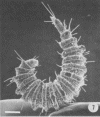


(from Cesaroni et al., 2017)
Rev. 12/02/2025
Phylum Nematoda
Class Chromadorea
Subclass Chromadoria
Order Desmoscolecida
Superfamily Desmoscolecoidea
mainly marine nematodes
have somatic setae
heavily ornamented and annulated cuticle, sometimes with scales, warts or spines and particle incustations (desmen).
Head offset, cephalic helmet or head cap; four cephalic setate.
Amphid apertures rounded or elongate.
Pigment spots (ocelli) may be present near junction of espohagus and intestine.
Stoma very small, cavity almost absent.
Esophagus tubular and short.
Tail with caudal glands and terminal spinneret
Females amphidelphic, didelphic, ovaries outstretched
Males without supplements; monorchic or diorchic.
Typically marine, some freshwater and soil, e.g. Desmoscolex vinealis from a vineyard soil in Germany and from rhixosphere of hedges in Austria and Belgium.(Decraener and Rho, 2013)
A unique group of nematodes characterized by desmens, thick transverse rings consisting of sedimentary particles and cementing material.. Cephalic tubercles (setae) are a useful diagnostic feature in taxonomy (Shirayama and Hope, 1992). Some genera spines (Grefiellla), scales (Paratricoma) or warts (Pareudesmoscolex) on the cuticle (Decraemer, 1978).
Two subfamilies are recognized:
Subfamilu Desmoscolecinae
Desmen separated by a zone of 2 to 5 annules which may be ornamented with pores and spines
Esophagus short
Males monorchic
Subfamily separated into two tribes:
Tribe Desmoscolecini
Body ornamented with a band of desmens or with concretion scales of secretions and fine particles, with pores or hairy spnes
Somatic setae glandular, subdorsal and subventral
Caudal glands often reduced
Type genus of the tribe: Desmoscolex
Tribe Greeffiellini
Adult cuticle with shallow annulation, lacking desmen but covered with spines or scales
Four cephalic setae, jointed or not, inserted in head
Somatic setae reduced in number, subventral setae usually absent in female
Type genus of the tribe: Greeffiella
Subfamily Tricominae
Desmen separated by a narrow, smooth zone of a single annule.
Esophagus longer
Males diorchic
Body cuticle with shallow annules ornamented with desmen, hairy spines or scales
Somatic setae with tricomoid pattern
Type genus of the subfamily: Tricoma
 |
 |
|
| Anterior view of head | ||
| Desmoscolex sp. from depths of Western Pacific Ocean | ||
| Photomicrographs by Shirayama and Hope, 1992 | ||
 |
||
| Tricoma sp.: Somatic
setae (from Cesaroni et al., 2017) |
||
References
Cesaroni, L. Guidi, L., Balsamo, M., Semprucci, F. 2017. Scanning electron microscopy in the taxonomical study of free-living marine nematodes. Microscopie 28:6970
Decraemer, W. 1978. Morphological and taxonomic study of the genus Tricoma Cobb (Nematoda : Desmoscolecida), with the description of new species from the Great Barrier Reef of Australia. Australian Journal of Zoology Supplementary Series 26(55) 1-121.
Decraemer, W. 1985. Revision and phylogenetic systematics of the Desmoscolecida (Nematoda). Hydrobiologia 120:259-283.
Decraemer, W. and Rho, H.S. 2013. 7.11 Order Desmoscolecida. In Schmidt-Rheas and de Gruyter, W. Handbook of Zoology.Gastrocticha, Cycloneuralia, Gnatifera. Volume 2: Nematoda
Decraemer, W. and Tchesunov, A.V. 1996. Some desmoscolids from the White Sea (Nematoda: Desmoscolecida). Russian J. Nematology 4:115-130.
Shirayama, Y. and Hope. W.D. 1992. Cephalic tubercles: a new character useful for the taxonomy of Desmoscolecida (Nematoda). Trans. Am. Microscop. Assoc: 111:211-222..